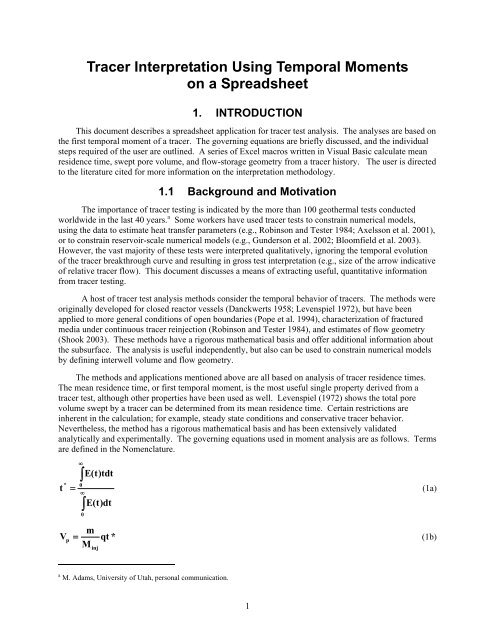Tracer Interpretation Using Temporal Moments on a Spreadsheet G
Tracer Interpretation Using Temporal Moments on a Spreadsheet G
Tracer Interpretation Using Temporal Moments on a Spreadsheet G
You also want an ePaper? Increase the reach of your titles
YUMPU automatically turns print PDFs into web optimized ePapers that Google loves.
<str<strong>on</strong>g>Tracer</str<strong>on</strong>g> <str<strong>on</strong>g>Interpretati<strong>on</strong></str<strong>on</strong>g> <str<strong>on</strong>g>Using</str<strong>on</strong>g> <str<strong>on</strong>g>Temporal</str<strong>on</strong>g> <str<strong>on</strong>g>Moments</str<strong>on</strong>g><br />
<strong>on</strong> a <strong>Spreadsheet</strong><br />
1. INTRODUCTION<br />
This document describes a spreadsheet applicati<strong>on</strong> for tracer test analysis. The analyses are based <strong>on</strong><br />
the first temporal moment of a tracer. The governing equati<strong>on</strong>s are briefly discussed, and the individual<br />
steps required of the user are outlined. A series of Excel macros written in Visual Basic calculate mean<br />
residence time, swept pore volume, and flow-storage geometry from a tracer history. The user is directed<br />
to the literature cited for more informati<strong>on</strong> <strong>on</strong> the interpretati<strong>on</strong> methodology.<br />
1.1 Background and Motivati<strong>on</strong><br />
The importance of tracer testing is indicated by the more than 100 geothermal tests c<strong>on</strong>ducted<br />
worldwide in the last 40 years. a Some workers have used tracer tests to c<strong>on</strong>strain numerical models,<br />
using the data to estimate heat transfer parameters (e.g., Robins<strong>on</strong> and Tester 1984; Axelss<strong>on</strong> et al. 2001),<br />
or to c<strong>on</strong>strain reservoir-scale numerical models (e.g., Gunders<strong>on</strong> et al. 2002; Bloomfield et al. 2003).<br />
However, the vast majority of these tests were interpreted qualitatively, ignoring the temporal evoluti<strong>on</strong><br />
of the tracer breakthrough curve and resulting in gross test interpretati<strong>on</strong> (e.g., size of the arrow indicative<br />
of relative tracer flow). This document discusses a means of extracting useful, quantitative informati<strong>on</strong><br />
from tracer testing.<br />
A host of tracer test analysis methods c<strong>on</strong>sider the temporal behavior of tracers. The methods were<br />
originally developed for closed reactor vessels (Danckwerts 1958; Levenspiel 1972), but have been<br />
applied to more general c<strong>on</strong>diti<strong>on</strong>s of open boundaries (Pope et al. 1994), characterizati<strong>on</strong> of fractured<br />
media under c<strong>on</strong>tinuous tracer reinjecti<strong>on</strong> (Robins<strong>on</strong> and Tester 1984), and estimates of flow geometry<br />
(Shook 2003). These methods have a rigorous mathematical basis and offer additi<strong>on</strong>al informati<strong>on</strong> about<br />
the subsurface. The analysis is useful independently, but also can be used to c<strong>on</strong>strain numerical models<br />
by defining interwell volume and flow geometry.<br />
The methods and applicati<strong>on</strong>s menti<strong>on</strong>ed above are all based <strong>on</strong> analysis of tracer residence times.<br />
The mean residence time, or first temporal moment, is the most useful single property derived from a<br />
tracer test, although other properties have been used as well. Levenspiel (1972) shows the total pore<br />
volume swept by a tracer can be determined from its mean residence time. Certain restricti<strong>on</strong>s are<br />
inherent in the calculati<strong>on</strong>; for example, steady state c<strong>on</strong>diti<strong>on</strong>s and c<strong>on</strong>servative tracer behavior.<br />
Nevertheless, the method has a rigorous mathematical basis and has been extensively validated<br />
analytically and experimentally. The governing equati<strong>on</strong>s used in moment analysis are as follows. Terms<br />
are defined in the Nomenclature.<br />
t<br />
*<br />
<br />
<br />
<br />
0<br />
<br />
<br />
0<br />
E(t)tdt<br />
E(t)dt<br />
(1a)<br />
V<br />
p<br />
<br />
m<br />
M<br />
inj<br />
qt *<br />
(1b)<br />
a M. Adams, University of Utah, pers<strong>on</strong>al communicati<strong>on</strong>.<br />
1
















